- Introduction to Amazon Elastic File System
- Amazon On-Demand Instance Pricing
- AWS Kinesis
- Amazon Redshift Tutorial
- Amazon SageMaker - AIs Next Game Changer
- AWS Console - Amazon Web Services
- AWS Architect Interview Questions
- AWS Architecture
- Amazon Athena
- Top 11 AWS Certifications List and Exam Learning Path
- How to Create Alarms in Amazon CloudWatch
- AWS CloudWatch Tutorial
- Introduction To AWS CLI
- AWS Configuration
- AWS Data Pipeline Documentation
- AWS EC2 Instance Types
- AWS Elastic Beanstalk
- AWS Elastic Beanstalk Available in AWS GovCloud (US)
- AWS Free Tier Limits and Faq
- AWS EC2 Instance Pricing
- Choosing The Right EC2 Instance Type For Your Application
- AWS Interview Questions And Answers
- AWS Key Management Service
- AWS Lambda Interview Questions
- AWS Lambda Tutorial
- What Is AWS Management Console?
- Complete AWS Marketplace User Guide
- AWS Outage
- AWS Reserved Instances
- AWS SDK
- What is AWS SNS?
- AWS Simple Queue Service
- AWS SysOps Interview Questions
- AWS vs Azure
- AWS Vs Azure Vs Google Cloud Free Tier
- Introduction to AWS Pricing
- Brief Introduction to Amazon Web Services (AWS)
- Clean Up Process in AWS
- Creating a Custom AMI in AWS
- Creating an Elastic Load Balancer in AWS
- How to Deploy Your Web Application into AWS
- How to Launch Amazon EC2 Instance Using AMI?
- How to Launch Amazon EC2 Instances Using Auto Scaling
- How to Sign Up for the AWS Service?
- How to Update Your Amazon EC2 Security Group
- Process of Installing the Command Line Tools in AWS
- Big Data in AWS
- Earning Big Money With AWS Certification
- AWS Certification Without IT Experience. Is It Possible?
- How to deploy a Java enterprise application to AWS cloud
- What is AWS Lambda?
- Top 10 Reasons To Learn AWS
- Run a Controlled Deploy With AWS Elastic Beanstalk
- Apache Spark Clusters on Amazon EC2
- Top 30 AWS Services List in 2024
- What is Amazon S3? A Complete AWS S3 Tutorial
- What is AMI in AWS
- What is AWS? Amazon Web Services Introduction
- What is AWS Elasticsearch?
- What is AWS ELB? – A Complete AWS Load Balancer Tutorial
- What is AWS Glue?
- AWS IAM (Identity and Access Management)
- AWS IoT Core Tutorial - What is AWS IoT?
- What is Cloud Computing - Introduction to Cloud Computing
- Why AWS Has Gained Popularity?
- Top 10 Cloud Computing Tools
- AWS Glue Tutorial
- AWS Glue Interview Questions
- AWS S3 Interview Questions
- AWS Projects and Use Cases
- AWS VPC Interview Questions and Answers
- AWS EC2 Tutorial
- AWS VPC Tutorial
- AWS EC2 Interview Questions
- AWS DynamoDB Interview Questions
- AWS API Gateway Interview Questions
- How to Become a Big Data Engineer
- What is AWS Fargate?
- What is AWS CloudFront
- AWS CloudWatch Interview Questions
- What is AWS CloudFormation?
- What is AWS Cloudformation
- What is AWS Batch
- What is AWS Amplify? - AWS Amplify Alternatives
- Types of Cloud Computing - Cloud Services
- AWS DevOps Tutorial - A Complete Guide
- What is AWS SageMaker - AWS SageMaker Tutorial
- Amazon Interview Questions
- AWS DevOps Interview Questions
- Cognizant Interview Questions
- Cognizant Genc Interview Questions
- Nutanix Interview Questions
- Cloud Computing Projects and Use Cases
- test info
By 2025, it is expected that the cloud computing sector will be worth $800 billion, making it one of the most lucrative industries. You will likely land a high-paying position in your dream company with a solid foundation and practical experience.
Additionally, this sector has many job openings, including cloud developer, cloud administrator, cloud architect, cloud engineer, and many more.
Some things to know about Cloud computing:
- Most businesses use Cloud computing to store their data and access it from anywhere. It is for this reason that experts in cloud computing are in such high demand all over the globe.
- A "pay as you go" model is frequently used in cloud computing, which can lower capital costs and expose users to unforeseen operating costs.
Let's address some frequently asked questions first, which will be divided into the two sections listed below.
Top 10 Cloud Computing Interview Questions
- What is Cloud?
- What is AWS in Cloud Computing?
- What are some of the key features of Cloud Computing?
- What are the top three types of cloud computing?
- List the three most important reasons for using the cloud.
- Identify the different types of data used by cloud computing.
- What are microservices, and why are they important in the cloud?
- What are Cloud-Native Applications?
- What are some popular open-source cloud-based database management systems?
- Why would you want to use cloud services?
Frequently asked questions for Fresher Graduates
1) What is Cloud?
The cloud is a worldwide network of servers, each with a specific function. It consists of hardware, networks, storage, services, and interfaces that contribute to the delivery of computing as a service.
2) What is Cloud Technology?
Cloud computing is a term that describes a modern generation of internet-based computer technology. The cloud is used by the following generation or stage of technology to make services accessible to users whenever and wherever they are. Additionally, it provides a way to connect to many servers spread throughout the globe.
| If you would like to become an AWS Certified professional, then visit Mindmajix - A Global online training platform: " Online AWS Training ".This course will help you to achieve excellence in this domain. |
3) What is AWS in Cloud Computing?
In cloud computing, Amazon provides its customers access to various information technology (IT) services through its Amazon Web Services (AWS) platform. It allows us to provide software on demand based on payment to customers who use services online. Together with hundreds of other companies around the world, we gain access to a cloud-based infrastructure platform that is dependable, scalable, and cost-effective. Amazon Web Services is a widely used platform for delivering cloud-based resources and applications developed by Amazon.
| Related Article: What is Cloud Computing? |
4) What are some of the largest cloud service providers and databases?
- Amazon SimpleDB
- Google BigTable
- Cloud-based SQL
5) Who first created the cloud?
Joseph Carl Robnett Licklider was the first to start the cloud. Although network-based computing has existed since the 1960s, many people believe that the first modern application of "cloud computing" occurred on August 9, 2006.
6) Who was behind the cloud's naming?
Rachel Boon has just looked at the ground-breaking work that Luke Howard has done; he is the one who named the clouds.
7) What are some of the key features of Cloud Computing?
Some of cloud computing's most distinguishing characteristics are as follows:
- Location Independence: This ensures that the materials are accessible from any location.
- Scalability: Data provisioning on demand is a key component of scalable systems.
- Multi-Tenancy: Many people use the same pool of available resources.
- Reliability: One can rely on the availability of resources and computation.
- Agility: Helps get resources back up and running quickly and cheaply.
8) Explain the structure of cloud computing architecture.
The cloud computing architecture includes all of the components of a cloud model that fit together architecturally.
The cloud service consumer represents the various uses of cloud services on the left side. Whatever the constituent's needs, it is critical to bring together the correct type of services that can support internal and external users. Consumer management should make services readily available to support changing business needs. This category includes applications, middleware, infrastructure, and services built on on-premises computing models.
Furthermore, the model depicts the role of a cloud auditor. This organization provides internal or external oversight to ensure that the consumer group fulfills its obligations.
9) Why do cloud services use APIs?
APIs (Application Programming Interfaces) are used in cloud platforms because
- It gives you another way to do things to write a partial program.
- It lets two or more applications talk to each other.
- It makes apps and connects cloud services to other systems.
10) What are the top three types of cloud computing?
There are primarily three types of cloud computing services:
- IaaS ( infrastructure as a service)
- PaaS (Platforms as a Service) and
- SaaS (software as a service)
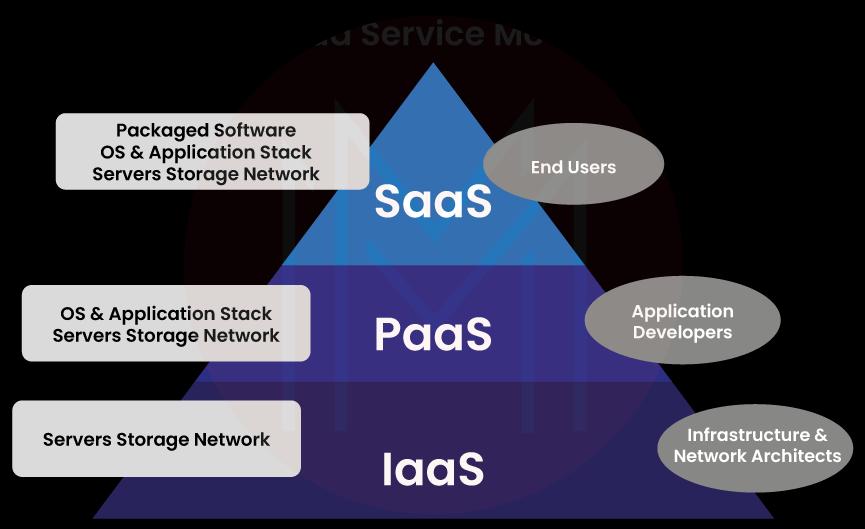
11) What is a private cloud?
Private clouds are used to ensure the security of strategic operations and other purposes. It is a complete, fully-functional platform that can be owned, operated, and restricted to a single organization or industry. Due to security concerns, most organizations have moved to private clouds today—using a hosting company's virtual private clouds.
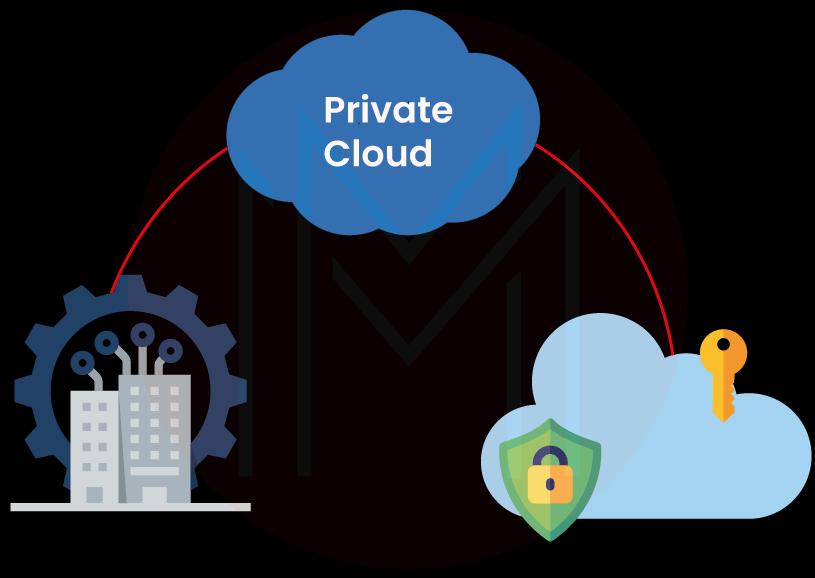
12) What is the public cloud?
The public clouds are available for use and deployment by the general public, such as Google and Amazon. The public clouds concentrate on a few layers, including cloud application, infrastructure, and platform markets.
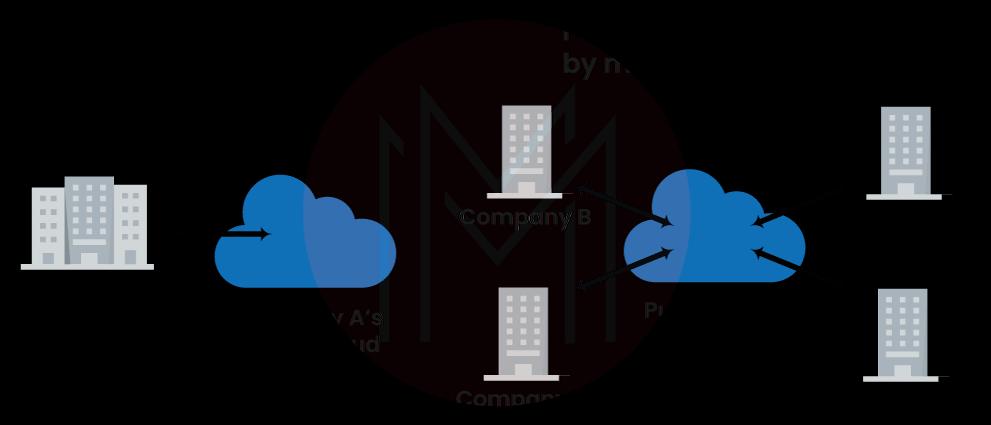
13) What are Hybrid clouds?
Public clouds and private clouds are both parts of a hybrid cloud. It is better than both clouds because it uses the most reliable way to set up cloud architecture. It has the best of both worlds in terms of functions and features. It lets businesses create their own clouds and give control of those clouds to someone else.
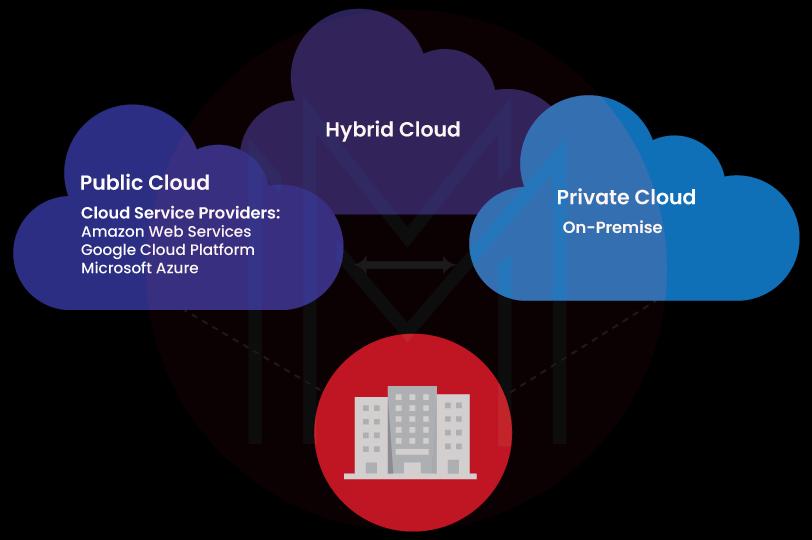
14) What are microservices, and why are they important in the cloud?
Microservices allow for the creation of platform- and language-independent software applications. Microservices are helpful in the cloud for the reasons listed below.
- Each is designed for a specific function. This simplifies app development.
- They make alterations simpler and quicker.
- Their scalability facilitates service evolution in response to fluctuating demand.
15) What advantages does cloud computing offer?
The advantages of cloud computing include the following-
- Backing up and storing data.
- Powerful server features and the ability to grow.
- You can get updates automatically.
- Better efficiency in working together and getting things done.
- Costs for managing and maintaining IT systems have gone down.
16) List the three most important reasons for using the cloud.
Let's look at the common reasons for using the cloud.
- Sharing files
- Keeping files
- Backing up data
| Related Article: Top 10 Cloud Computing Tools |
Frequently asked questions for Experienced Professionals
17) What is an API Gateway?
A group of APIs can provide a unified user experience through an API gateway. Here, each API call is processed efficiently and consistently.
With the help of the API gateway, all APIs can be managed from a single location and protected to an enterprise standard. The API gateway can handle the routine operations of the API services. Among these responsibilities are providing services like data collection and analysis, rate limiting, and user authentication.
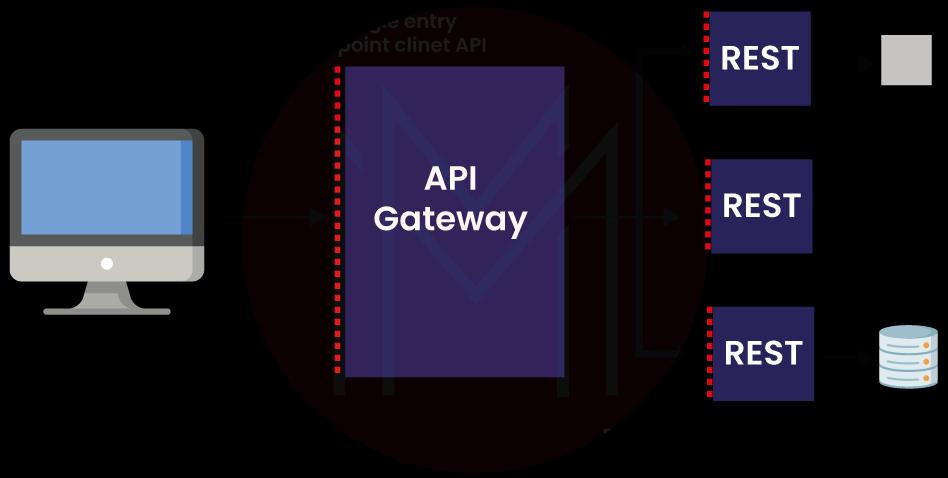
18) List three cloud computing applications.
- Multi-cloud and hybrid clouds
- Development and testing
- Big data analytics
The public cloud refers to the internet in its most basic form. Services such as Gmail and Dropbox, typically considered part of the internet, are examples of what is included in public cloud computing solutions.
20) Identify the different types of data used by cloud computing?
In cloud computing, there are many different kinds of data, just like there are many different kinds of data in other contexts, such as emails, contacts, images, and blogs. We are well aware that there is a daily increase in the amount of data, and as a result, there is a need for new types of data to store this additional information.
21) What are the different parts of cloud architecture?
Below are the different parts of cloud architecture
- NC or Node Controller
- SC or Storage Controller
- CLC or Cloud Controller
- Walrus
- Cluster Controller
22) What are Cloud-Native Applications?
To put it simply, "cloud native" refers to a software framework that is built around cloud computing concepts such as containers, microservices, dynamic orchestration, and continuous delivery. Each component of a cloud-native app runs in its own container and communicates with others in real time to share resources effectively.
23) What are the different large-scale cloud computing platforms?
Several platforms are used for large-scale cloud computing, such as
- MapReduce
- Apache Hadoop
24) What are the various layers of cloud computing?
Cloud computing is made up of three parts.
- IaaS provides hardware-related cloud services like memory, processor, speed, etc.
- PaaS describes how a cloud-based platform for building software is made available to programmers.
- SaaS is a model for delivering software whereby users can access cloud-based programs without installing the program locally. These programs are always stored online.
25) What are the different types of models used in cloud computing?
Models for deploying cloud computing include:
- Hybrid cloud
- Private cloud
- Public cloud
- Community cloud
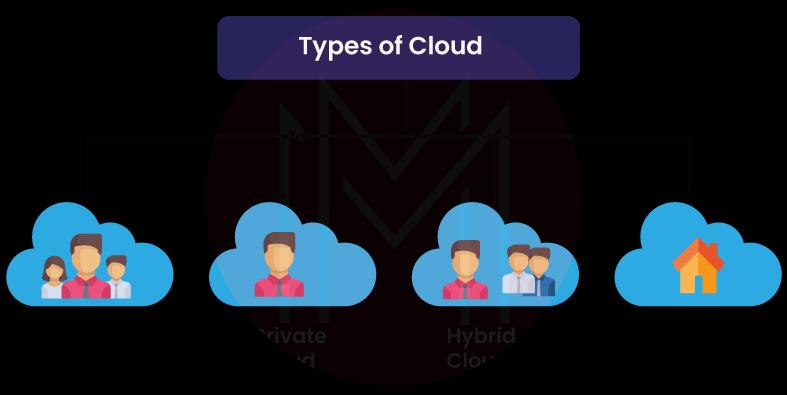
26) List a few differences between cloud computing and mobile computing?
Mobile and cloud computing are conceptually related. Mobile computing primarily makes use of cloud computing.
Cloud computing provides users with the required data, whereas mobile computing runs applications on a remote server and gives users access to storage and management.
27) What are some popular open-source cloud-based database management systems?
Some of the databases on open-source cloud computing platforms are –
- MongoDB: This database system is document-oriented, so it doesn't need a specific schema to store information. It is a great option for data archiving due to its large storage capacity and well-written C++ code.
- CouchDB: The database stores information in documents rather than rows and columns in a traditional relational database. It has a large capacity and is written in the C++ programming language.
- LucidDB: Data warehousing uses this Java/C++ database.
28) How is scalability different from elasticity?
Cloud computing can be scaled up, which means that more resources can be added to handle the growing amount of work. By using scalability and an architecture that makes adding resources when traffic needs them easy.
Elasticity is just a property that makes it possible to quickly turn on and turn off a large number of resources on a capacity. It is also judged by how quickly (in terms of data transfer speed) the requested resources are found and used.
29) What are the most important steps before using a cloud-based computing platform?
- Compliance
- Loss of data
- Data storage
- Business continuity
- Uptime
- Data integrity in cloud computing
30) What is the purpose of utility computing?
In utility computing, a company decides what kinds of cloud services are necessary and acts as the plug-in manager. As a bonus, users can more easily pay for their required services.
31) What is the "EUCALYPTUS" of cloud computing?
The acronym is Elastic Utility Computing Architecture for Linking Your Program to Useful Systems. It is mainly made up of an open-source software infrastructure that is used to set up clusters in cloud computing platforms.
32) What open-source platforms are used for cloud databases?
There are many open-source cloud computing platform databases to choose from, including CouchDB, MongoDB, and LucidDB, amongst many others.
33) Give some examples of cloud service providers and databases?
The cloud service providers and databases examples below include a few.
- Amazon SimpleDB
- Google BigTable
- Cloud-based SQL.
34) Why would you want to use cloud services?
Among the most significant advantages of cloud services are the following:
- Scalable and Robust: Scalable and trustworthy applications are easier to develop with their help.
- Saving money: This helps the business world make good use of investments.
- Time-saving: The time required for deployment and maintenance is significantly decreased.
35) What kinds of data centers are used for cloud computing?
The different kinds of data centers include
- Low-density datacenter
- Containerized data centers
Conclusion
In recent years, cloud computing has become an in-demand job as its applicability has expanded beyond IT firms. With the proper skill sets and knowledge, you can also enter the world of cloud computing and advance your career by using these interview questions and answers. Interview-preparing candidates can use this article on cloud computing interview questions to brush up on the fundamentals of cloud technology in succeeding for their interviews.
 On-Job Support Service
On-Job Support Service
Online Work Support for your on-job roles.

Our work-support plans provide precise options as per your project tasks. Whether you are a newbie or an experienced professional seeking assistance in completing project tasks, we are here with the following plans to meet your custom needs:
- Pay Per Hour
- Pay Per Week
- Monthly
| Name | Dates | |
|---|---|---|
| AWS Training | Jan 17 to Feb 01 | View Details |
| AWS Training | Jan 20 to Feb 04 | View Details |
| AWS Training | Jan 24 to Feb 08 | View Details |
| AWS Training | Jan 27 to Feb 11 | View Details |

Madhuri is a Senior Content Creator at MindMajix. She has written about a range of different topics on various technologies, which include, Splunk, Tensorflow, Selenium, and CEH. She spends most of her time researching on technology, and startups. Connect with her via LinkedIn and Twitter .
















